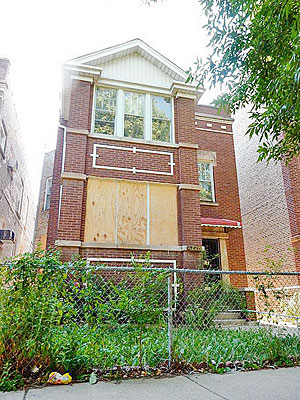
Between 2009 and 2011, about 10 percent of Chicago’s rental housing passed through some stage of foreclosure, often leaving paid-up tenants in a gray area when a building’s foreclosing lender didn’t resell the place to a new landlord quickly. That’s where Nancy Enopena found herself this past winter after the Albany Park house where she rents a bedroom was without heat or hot water for five months—and without any water at all for several weeks.
Before a judge got the utilities turned back on, Enopena said that she bathed by heating water in an electric rice cooker and pouring it into a bucket. Recounting the winter shutdown to me Monday, Enopena broke down in tears. She works as a caregiver at a low wage, she explained, and had no option to move out of the $150-a-month rental room.
Now a coalition of Chicago neighborhood associations, aldermen, and the Cook County sheriff are working on legislation that would protect people like Enopena, as well as tenants who are evicted by foreclosing lenders. The Keep Chicago Renting Ordinance would require lenders to leave existing tenants in place—except where eviction is a legitimate option, such as criminal activity or nonpayment of rent—during the months or years before a building is resold to a new landlord. “People should not be displaced just because the landlord went [bad] and the bank doesn’t want to be a landlord,” said Diane Limas, a longtime activist on renters’ rights in foreclosure. “The buildings get boarded up, the kids get moved to new schools in the middle of the year, the people aren’t shopping in our stores anymore. That’s destabilizing for our communities.”
If approved, the ordinance would apply expressly to the period between the time a lender takes legal possession of a building and when it sells to a new owner. Lenders would not only have to keep tenants in place, but they would have to keep the building maintained, inform tenants of all contact information, and make sure the utilities stay on. A provision would allow the lender to apply to a judge to raise rents if it can be demonstrated that the rental income is not sufficient to cover the costs the building incurs. “We aren’t neglecting the banks,” said Limas. “We have that safeguard in there for them.”
No organized opposition to the ordinance has surfaced yet, but a potential sticking point could be the cost to lenders of keeping rental buildings up and running. A lender not in the business of managing rental property may consider ousting tenants and temporarily closing the building a more cost-effective option.
Limas is part of the Albany Park Neighborhood Council, which is working on this issue with similar organizations in Kenwood/Oakland and Brighton Park, as well as with the Metropolitan Tenants Organization, the Chicago Coalition for the Homeless, and others. The ordinance, to be introduced for scheduling at next week’s Chicago City Council meeting, has Aldermen Richard Mell (33rd), Joseph Moore (49th), and Pat Dowell (3rd) as its chief sponsors; eight other aldermen have signed on. (Mell is out of town until July 2; I have not received calls back from Moore or Dowell.) It also has the backing of Sheriff Tom Dart.
Though investors are buying up single-family homes and large rental buildings, “nobody’s buying the smaller three- and four-flats in our neighborhood,” Limas said. “They sit vacant, and it’s tearing apart communities. No new businesses want to come in when they see the [boarded-up buildings].”
In 2010, the city’s Department of Buildings spent about $13.7 million to board up or demolish derelict foreclosures; Streets and Sanitation spent about $1.8 million on general upkeep on vacant properties. “We could spend that money on something positive for the city,” Limas suggested.



